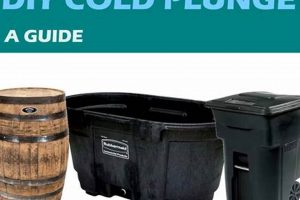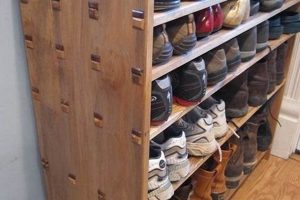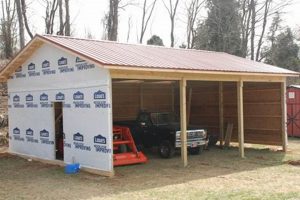The creation of customized shapes for baking is facilitated through various methods, allowing individuals to produce edible designs tailored to specific themes or occasions. One common approach involves manipulating readily available materials, such as aluminum flashing or even repurposed cans, into desired outlines. These homemade implements serve as molds for dough, enabling the baker to create cookies in non-standard forms. For example, a child’s birthday party might feature treats shaped like favorite animals, constructed using tools fashioned at home.
The ability to craft baking tools provides several advantages. It offers a cost-effective alternative to purchasing pre-made options, especially when unique or specialized forms are needed. Furthermore, the process encourages creativity and personalization in baking, permitting the production of treats aligned with individual preferences or event themes. Historically, this resourcefulness reflects a tradition of adapting household materials for practical purposes, a skill valued in many cultures.
Understanding the fundamental techniques for shaping metal and other materials, as well as considering food safety, becomes paramount when embarking on the endeavor of producing custom baking tools. The selection of suitable materials and the development of appropriate design concepts will be discussed, paving the way for exploring various methods of creation and ensuring a safe and enjoyable baking experience.
Tips for Homemade Baking Molds
Careful planning and execution are essential when producing baking molds at home. The following guidelines will assist in creating safe and functional tools for shaping dough.
Tip 1: Material Selection: Opt for food-grade materials such as stainless steel or aluminum. Avoid using copper or galvanized metals, as they can leach into the food and pose a health risk.
Tip 2: Smooth Edges: Ensure all edges are smooth and free of sharp points. This prevents injury during use and ensures clean cuts in the dough. Sanding or filing metal edges is recommended.
Tip 3: Secure Joints: When joining pieces to create a shape, utilize food-safe solder or rivets. Ensure the connections are robust and will not separate during use, potentially contaminating the dough.
Tip 4: Design Considerations: Favor simple designs without intricate details. Complex shapes can be difficult to cut cleanly and may result in dough sticking within the mold. Large, continuous lines are generally more effective.
Tip 5: Hygiene Practices: Thoroughly clean and sanitize the finished product before each use. Wash with hot, soapy water and dry completely to prevent bacterial growth and ensure food safety.
Tip 6: Storage: Store homemade baking molds in a dry place to prevent rust or corrosion, extending the life of the tool.
Adhering to these guidelines ensures the production of durable, safe, and effective tools for creating uniquely shaped baked goods. Prioritizing food safety and careful craftsmanship contributes to a positive baking experience.
With these tips in mind, the next section will explore advanced techniques and creative possibilities in homemade baking mold design.
1. Shape Design
Shape design is a foundational element in the effective creation of baking implements, directly influencing the final appearance and recognizability of the baked good. The process entails careful consideration of the intended form, its complexity, and its suitability for successful reproduction in dough.
- Complexity and Intricacy
The level of detail incorporated into a shape design affects the ease with which it can be replicated in dough. Highly intricate designs, while visually appealing, often present challenges during the cutting and baking process. Fine details can be lost, resulting in a less defined final product. Simple, bold shapes tend to translate more effectively into baked goods, maintaining their form and recognizability throughout the process. A complex snowflake pattern, for example, may lose its delicate arms, whereas a simple star maintains its points.
- Structural Integrity
Shape design considerations extend to the structural integrity of the resulting baked good. Designs with thin or unsupported areas are prone to breakage during handling or baking. Ensuring that the design incorporates sufficient points of connection and support is crucial for maintaining the shape’s integrity. A design featuring a tall, narrow figure, for instance, may require a wider base to prevent it from toppling over or breaking.
- Edge Smoothness and Definition
The smoothness and definition of the edges in a shape design directly impact the final presentation of the baked good. Clean, well-defined edges contribute to a professional and polished appearance. Conversely, jagged or uneven edges can detract from the overall aesthetic. Sharp, consistent lines are preferred to ensure a clear and visually appealing result. A design with rounded, flowing lines will produce a softer-edged cookie than one with sharp, angular points.
- Positive and Negative Space
The distribution of positive and negative space within a shape design influences the clarity and legibility of the final product. Excessive negative space, or empty areas within the design, can weaken the structure and make the shape difficult to recognize. Conversely, insufficient negative space can lead to a cluttered and indistinct appearance. Balancing the ratio of positive to negative space is essential for creating a visually appealing and easily identifiable form. Consider a letter; a well-designed letter will have enough internal space to be clearly distinguished from other letters.
Ultimately, successful shape design for baking applications involves a balance between aesthetic considerations and practical limitations. By carefully considering complexity, structural integrity, edge smoothness, and the distribution of space, individuals can create customized baking implements that produce visually appealing and structurally sound baked goods.
2. Material Safety
The selection of materials for crafting baking implements directly impacts food safety and consumer health. The interaction between the dough and the material from which the mold is constructed can introduce contaminants, posing a potential health risk. Therefore, prioritizing food-grade materials is essential. The construction of a baking mold from repurposed household items, such as discarded aluminum cans not specifically manufactured for food contact, presents an example of the dangers of improper material selection. Such materials may contain coatings or alloys that leach into the dough during cutting or baking, rendering the finished product unsafe for consumption.
Food-grade stainless steel and aluminum are generally considered s
afe choices for crafting baking implements. These materials are relatively inert and resistant to corrosion, minimizing the risk of chemical leaching. However, even with these materials, proper sourcing and preparation are necessary. For instance, ensuring that stainless steel sheets used for construction are specifically designated as food-grade, and that all manufacturing oils and residues are thoroughly removed before use, is critical. Similarly, the use of lead-based solder to join pieces together is strictly contraindicated due to the known toxicity of lead. The lack of stringent material control in homemade baking mold production necessitates a heightened awareness of potential contamination risks and adherence to best practices for material selection and handling.
In summary, material safety represents a non-negotiable aspect of crafting homemade baking implements. The choice of materials can directly affect the safety and edibility of the baked product. By adhering to stringent selection criteria, prioritizing food-grade options, and implementing thorough cleaning procedures, individuals can mitigate the risks associated with material contamination and ensure a safe and enjoyable baking experience. The challenges lie in identifying reliable material sources and understanding the potential risks associated with various metals and alloys, emphasizing the need for informed decision-making and responsible craftsmanship.
3. Cutting Edge Sharpness
The degree of acuity present on the cutting surface of a homemade baking implement directly correlates with its functional efficacy and the resultant quality of the dough separation. The sharpness of this edge determines the ease and precision with which the implement can penetrate and cleanly sever the dough, influencing the final shape and appearance of the baked good.
- Dough Type and Resistance
Variations in dough consistency and composition necessitate corresponding adjustments in edge sharpness. A delicate, shortbread dough, for instance, may require a less aggressive edge to prevent tearing or distortion. Conversely, a dense, stiff dough might demand a significantly sharper edge to ensure a clean cut without excessive force. The interaction between dough characteristics and edge sharpness directly influences the fidelity of the shape transfer.
- Material Properties and Durability
The material from which the baking implement is constructed dictates the achievable and maintainable sharpness of the cutting edge. Softer materials, such as thin aluminum, are easily shaped but tend to dull more quickly with repeated use. Harder materials, like stainless steel, can maintain a sharper edge for a longer duration but require more specialized tools and techniques for shaping and sharpening. The balance between material malleability and edge retention is a critical design consideration.
- User Safety and Handling
While a sharp cutting edge is essential for effective dough separation, it also introduces a potential risk of injury to the user. The design must incorporate safety features, such as rounded corners or protective grips, to minimize the likelihood of accidental cuts. The sharpness should be optimized for performance without compromising the user’s safety during handling and manipulation of the implement.
- Cleanliness and Hygiene
A dull or damaged cutting edge can create microscopic crevices and imperfections that trap dough residue, fostering bacterial growth and compromising hygiene. A sharp, smooth edge facilitates thorough cleaning and sanitization, minimizing the risk of contamination. The ease with which the cutting edge can be cleaned directly impacts the overall food safety of the baking process.
Therefore, the sharpness of the cutting edge is not merely a superficial characteristic but a critical determinant of a homemade baking implement’s functionality, safety, and hygiene. Careful consideration of dough properties, material durability, user safety, and cleaning requirements is essential for optimizing the design and construction of these implements.
4. Joint Strength
The structural integrity of a homemade baking implement is directly contingent upon the robustness of its joints. Insufficient joint strength compromises the tool’s ability to withstand repeated use and forces applied during dough cutting, leading to deformation, breakage, and potential contamination. A baking implement fashioned from multiple segments, such as one creating an intricate gingerbread man, exemplifies the critical role of strong joints. If the joints connecting the arms or legs to the torso are weak, the tool may flex or separate under pressure, resulting in distorted cookies or rendering the implement unusable. Therefore, reliable joint construction is a fundamental aspect of baking implement design.
Effective joint construction requires careful consideration of material compatibility and appropriate joining techniques. Soldering, brazing, riveting, and food-safe adhesives represent common methods for creating durable bonds between component parts. The suitability of each method varies depending on the materials used and the intended application. For example, soldering stainless steel requires specialized solder alloys and techniques to achieve a strong, corrosion-resistant bond. Improperly executed soldering can result in weak joints susceptible to failure and potentially introducing lead contamination if lead-based solder is used. Mechanical joints, such as rivets, offer an alternative approach that avoids the use of potentially hazardous materials but necessitate precise alignment and secure fastening to prevent loosening over time. Furthermore, adhesives must be specifically formulated for food contact applications to prevent the leaching of harmful chemicals into the dough.
Ultimately, joint strength constitutes a key determinant of the longevity, functionality, and safety of a homemade baking implement. Weak joints not only impair the tool’s performance but also pose a risk of structural failure, leading to product contamination and potential injury. Prioritizing robust joint construction, through careful material selection and appropriate joining techniques, is therefore essential for ensuring the creation of durable and reliable baking implements. The challenge lies in selecting methods that provide both adequate strength and food safety compliance, demanding informed decision-making and meticulous craftsmanship.
5. Ease of Cleaning
The ease with which a homemade baking implement can be thoroughly cleaned directly impacts its hygienic safety and long-term usability. The intricate shapes often associated with customized baking implements present inherent challenges to cleaning, creating potential harborage points for bacteria and dough residue. The materials and construction methods employed in their creation further influence their cleanability, rendering some designs inherently more susceptible to contamination than others. For instance, a baking mold crafted from multiple segments and joined with crevices will be considerably more difficult to clean effectively than a single-piece design with smooth surfaces. The persiste
nce of dough remnants within these hard-to-reach areas can promote microbial growth, posing a food safety risk.
The selection of materials and the complexity of the design exert a significant influence on the efficiency of cleaning procedures. Porous materials, such as unfinished wood, are generally unsuitable for crafting baking implements due to their inherent susceptibility to absorbing liquids and harboring bacteria. Conversely, non-porous materials like stainless steel offer a smoother surface that is less prone to trapping food particles. Furthermore, the design should minimize the presence of sharp corners, narrow crevices, and intricate details, as these features impede thorough cleaning. The use of dishwashers to sanitize baking implements necessitates the selection of materials that can withstand high temperatures and harsh detergents without degradation or corrosion. For example, while aluminum is a common material, certain detergents can cause it to oxidize or pit, creating additional surfaces for bacterial attachment.
The cleanability of a baking implement is not merely a superficial consideration but a fundamental aspect of ensuring food safety and preventing cross-contamination. Designs that prioritize smooth surfaces, simple geometries, and dishwasher-safe materials facilitate effective cleaning and contribute to a more hygienic baking process. The challenges associated with cleaning intricate designs and incompatible materials underscore the importance of considering ease of cleaning as a primary criterion in the design and construction of homemade baking implements. Prioritizing cleanability from the outset reduces the risk of bacterial contamination and ensures the long-term usability of the tool.
Frequently Asked Questions
This section addresses common inquiries regarding the creation and utilization of customized baking implements. The information presented aims to clarify best practices and mitigate potential risks associated with homemade tools.
Question 1: What materials are strictly prohibited for crafting a baking implement?
Materials containing lead, cadmium, or other toxic heavy metals are strictly prohibited. Galvanized metals, unless specifically certified as food-safe, should also be avoided due to the potential for zinc leaching. Certain plastics not rated for high-temperature food contact are unsuitable.
Question 2: How can one ensure the cutting edge is sufficiently sharp without posing a safety hazard?
A fine balance must be achieved. The edge should be sharp enough to cleanly sever dough but not so sharp as to present an unreasonable risk of injury during handling. Rounded corners and the use of protective grips can mitigate this risk.
Question 3: What techniques are most effective for creating durable and food-safe joints between multiple implement pieces?
Food-grade soldering or brazing techniques, employing lead-free solder, are acceptable. Mechanical fasteners such as rivets can also be used, provided they are securely fastened and do not create crevices that trap food particles. Certain food-safe adhesives may be suitable, contingent upon their temperature resistance and non-toxicity.
Question 4: How frequently should a baking implement be cleaned, and what cleaning methods are recommended?
The implement should be cleaned thoroughly after each use. Hot soapy water is generally sufficient for cleaning. For implements that are dishwasher-safe, high-temperature cycles provide additional sanitation. Ensure the implement is completely dry before storage to prevent corrosion or bacterial growth.
Question 5: Is it permissible to create baking implements from repurposed household items, such as aluminum cans?
Repurposed materials are generally discouraged unless the material’s composition and prior usage history are definitively known and verified as food-safe. Aluminum cans, in particular, may have coatings or residues that are not suitable for food contact.
Question 6: How does the design complexity impact the cleanability and structural integrity of a baking implement?
Intricate designs with sharp corners, narrow crevices, or unsupported elements are inherently more difficult to clean and more prone to structural failure. Simpler designs with smooth surfaces and robust construction are preferred.
In conclusion, the safe and effective creation of baking implements requires careful attention to material selection, edge sharpness, joint strength, cleanability, and design complexity. Adherence to these guidelines minimizes potential risks and ensures a satisfactory baking experience.
The subsequent section will explore alternative techniques and innovative approaches to baking implement design, expanding on the concepts discussed herein.
Conclusion
This exploration of diy cookie cutter creation underscores the confluence of creativity, technical skill, and food safety awareness. The preceding sections have elucidated the importance of material selection, design considerations, cutting edge sharpness, joint strength, and ease of cleaning. These elements collectively determine the safety, functionality, and longevity of homemade baking implements. A thorough understanding of these principles is paramount for individuals seeking to craft custom baking tools.
The production of diy cookie cutter requires meticulous attention to detail and a commitment to responsible craftsmanship. While the allure of personalized baking shapes is undeniable, prioritizing food safety and structural integrity remains paramount. Continued research into innovative materials and techniques will further enhance the accessibility and safety of this practice. The future of homemade baking implements rests on a foundation of informed decision-making and adherence to established best practices.







